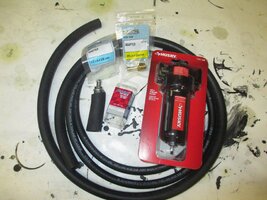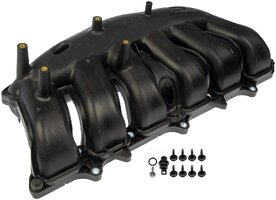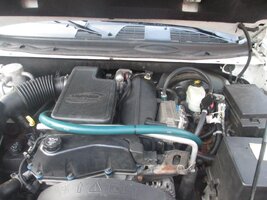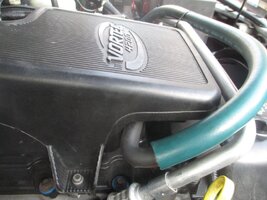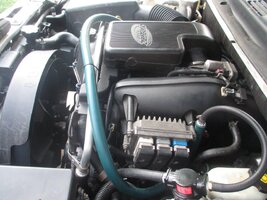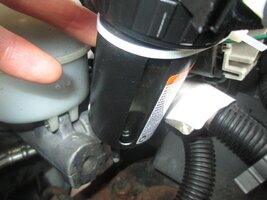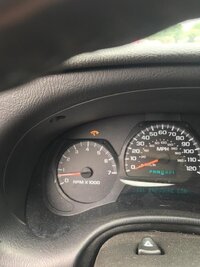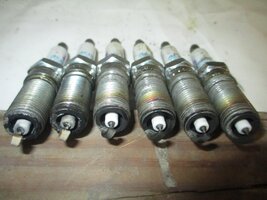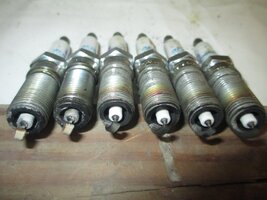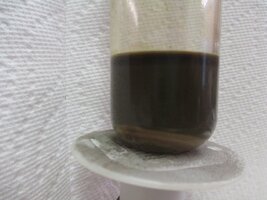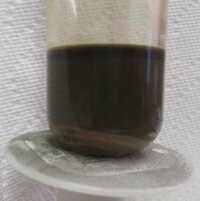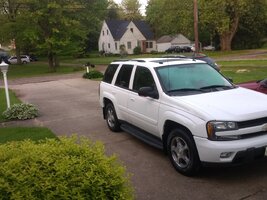EPfiffner
Member
Homemade catch can / PCV retrofit:
I got a husky air compressor moisture separator, 3/8" NPT at home depot.
For fittings, I bought a 1/2" hose barb to 3 /8" npt for the inlet to the separator.
The outlet fitting is 3/8" hose barb to 3 /8" npt, this will go to the PCV valve.
At autozone, I returned the $200 fuel pressure test kit, and bought a gallon of Mobil 1, which I have been seeing a lot of lately...
I also bought:
3/8 fuel hose, 6'. This connects from the outlet fitting of the catch can to the PCV valve
1/2" emission hose, 6 '. This connects from the intake manifold vacuum nipple to the inlet fitting of the catch can.
6' of either hose is way more than needed.
I wanted a straight PCV valve (not 90 deg) so I thought of my '93 Beretta 3.1 V6. They had it in stock.
I had in my garage: 3/4" heater hose, about 3" long. This fits over the oem " dirty air" hose, and also over the base of the PCV valve.
On the 4.2l, the dirty air emission hose is low on the intake manifold, it's a 90 deg 1/2" hose. The top connection is a slip fit, and it's manifold vacuum.
The bottom connection is clamped and I can't tell exactly where it goes, it appears to be back in to the manifold. This is the connection to the crankcase vapors.
What I did: disconnected this hose at the upper connection, left it clamped in place where it runs to the crankcase.
I slipped the heater hose over the oem crankcase vent hose, and put the PCV valve in the other end of the heater hose.
I then ran 3/8 hose from the PCV to the outlet of the catch can.
For the inlet side, I ran the 1/2" hose from the intake manifold vacuum nipple directly to the inlet side of the catch can.
The moisture separator is equipped with a spring loaded auto drain, which is a problem when you apply vacuum. The drain has a barbed nipple, so I just plugged it with a short piece of vacuum hose plugged it a screw for now.
I hurried to get everything sourced and installed early Saturday morning because I knew we were going on a 60mi drive. Upon returning home I checked and was surprised to find it was pretty much dry. I then realized I had the separator installed backwards, oops. I have since corrected, so we will see how it goes.
I have been losing a lot of sleep over this, and there's plenty more to come.
I've also noticed that any time I see ours, or any other TB on the road or in a parking lot, I give it a side-eyed glare.
I got a husky air compressor moisture separator, 3/8" NPT at home depot.
For fittings, I bought a 1/2" hose barb to 3 /8" npt for the inlet to the separator.
The outlet fitting is 3/8" hose barb to 3 /8" npt, this will go to the PCV valve.
At autozone, I returned the $200 fuel pressure test kit, and bought a gallon of Mobil 1, which I have been seeing a lot of lately...
I also bought:
3/8 fuel hose, 6'. This connects from the outlet fitting of the catch can to the PCV valve
1/2" emission hose, 6 '. This connects from the intake manifold vacuum nipple to the inlet fitting of the catch can.
6' of either hose is way more than needed.
I wanted a straight PCV valve (not 90 deg) so I thought of my '93 Beretta 3.1 V6. They had it in stock.
I had in my garage: 3/4" heater hose, about 3" long. This fits over the oem " dirty air" hose, and also over the base of the PCV valve.
On the 4.2l, the dirty air emission hose is low on the intake manifold, it's a 90 deg 1/2" hose. The top connection is a slip fit, and it's manifold vacuum.
The bottom connection is clamped and I can't tell exactly where it goes, it appears to be back in to the manifold. This is the connection to the crankcase vapors.
What I did: disconnected this hose at the upper connection, left it clamped in place where it runs to the crankcase.
I slipped the heater hose over the oem crankcase vent hose, and put the PCV valve in the other end of the heater hose.
I then ran 3/8 hose from the PCV to the outlet of the catch can.
For the inlet side, I ran the 1/2" hose from the intake manifold vacuum nipple directly to the inlet side of the catch can.
The moisture separator is equipped with a spring loaded auto drain, which is a problem when you apply vacuum. The drain has a barbed nipple, so I just plugged it with a short piece of vacuum hose plugged it a screw for now.
I hurried to get everything sourced and installed early Saturday morning because I knew we were going on a 60mi drive. Upon returning home I checked and was surprised to find it was pretty much dry. I then realized I had the separator installed backwards, oops. I have since corrected, so we will see how it goes.
I have been losing a lot of sleep over this, and there's plenty more to come.
I've also noticed that any time I see ours, or any other TB on the road or in a parking lot, I give it a side-eyed glare.
Attachments
Last edited by a moderator:


